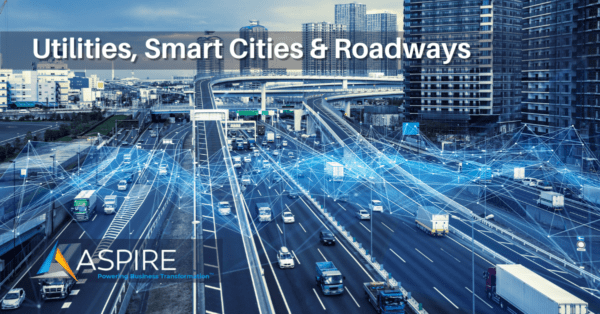The IoT of Utilities, Smart Cities, and Roadways
Written by Carter Yepsen, Director, Business Development for IoT at Aspire Technology Partner
IoT for utilities, Smart Cities, and roadways holds great promise for older northeastern U.S. cities with aging infrastructure. For many practical reasons, these cities, including Boston, Providence, Hartford, New York City, Philadelphia, and Washington D.C., were built largely along waterways.
They form an entire Amtrak Acela line of cities built along the Atlantic, the Charles River, the Hudson River, the Delaware River, the Potomac River, and so on. There is a lot of convenience, a lot of beauty, and a lot of history.

On the downside, that long history means that our northeastern cities are older, and, therefore, their infrastructure is older as well. And that has caused some challenges as we look at today’s demands around travel, transportation, and logistics, including things like the impact of climate change and poor weather conditions on road travel.
Something as simple as salting roadways to make them less icy can have a huge impact on the condition of the road surface and the environment. Roadways, bridges, tunnels, buildings, and other transportation infrastructure are liable to damage from caustic road salt. In addition, it is harmful to vegetation, wildlife, and pets.
Icy conditions will remain. As we have seen with the recent storms in the southwest, this is a nationwide issue. So, cities are frequently looking for a balance between safe roads and using less salt, including brine and sand and other alternatives.
And this is just one small area where the Internet of Things (IoT) provides a way for municipalities and communities to become Smart Cities and proactively manage and protect their utilities, infrastructure, and the environment.
Related: Take a virtual tour of the Aspire IoT Demonstration Center
Road Surface Monitoring

An IoT Pavement Monitor is an infrared technology device that can be mounted to an existing utility pole to monitor and report the road surface condition. Based on the data received, municipalities can make informed decision about the amount and type of road surface deicer to deploy or, for example, whether to use sand to increase traction. These same Pavement Monitors are often mounted on snowplowing trucks to manage the amount of material that the trucks may distribute to the roadway.
And it is not just the sanding and salting of the roads during an icy season; the roadway cleanup in the spring wreaks havoc on roadways, storm sewers, and surrounding vegetation. That is why simply monitoring and managing the amount and type of material used to combat icy conditions can create cost savings and reduce environmental impact. One municipality I know outside of Boston has saved hundreds of thousands of dollars per year in infrastructure reconstruction by doing this.
IoT Mesonet Weather Stations
The prevalence of storms and the way they can affect a small, specific region has led many states to invest in mesonets – a weather and environmental monitoring station network designed to observe and report on local weather events ranging between 1 mile to 150 miles and often lasting between several minutes to several hours.
This IoT-based system enables the micro-monitoring of weather events that allows municipalities, utilities, and transportation companies to become more granular about how they respond and modify their operations in response to an event. This means that a municipality that needs to schedule resources, like plowing and refuse pickup, can now operate much more efficiently.
IoT On the Ground and In the Air
 Big data like this has become big business. Companies like IBM process data from state mesonets through its AI systems to produce critical response data for municipalities and enterprises.
Big data like this has become big business. Companies like IBM process data from state mesonets through its AI systems to produce critical response data for municipalities and enterprises.
Similarly, Southwest Airlines uses sensors to audit and collect information about moisture in the atmosphere, which they then sell to other companies. Weather-related data helps transportation and utilities improve operations and efficiency. The trend will continue and grow as these types of networks become more prevalent and as individual sensors become more affordable.
In another example, a northeastern university customer has deployed IoT monitoring sensors to monitor the level of water and sediment caused when their storm drains overflow so that they can report the condition to their state government. This storm water response system will eventually monitor the level of water, amount of sediment, and turbidity of water – a factor in water clarity – to help them mitigate and eliminate overflows into nearby public sewers or waterways.
We have also seen IoT sensors deployed by customers in “environmental justice areas”. In New York State, the Office of Environmental Justice (OEJ) focuses on environmental challenges affecting primarily low income and minority communities. These communities have documented higher rates of asthma and other health challenges from air-borne pollutants.
Cities across the state are looking to measure and monitor these conditions for the purpose of proactively enforcing state environmental laws and regulations.
In one county, asthma attacks are the number one cause for juvenile admittance into emergency rooms. This county sends alerts about poor air quality to people with known respiratory problems and urges them to remain indoors and run an air conditioner or air purifier.
The system also provides necessary information about truck routes. Long diesel engine idling within the environmental justice area negatively impacts air quality. Counties and cities may determine whether to reroute these trucks in their efforts to deliver better air quality to citizens.
By measuring a reduction in air-borne pollutants, the county and OEJ can see whether they have been able to reduce the number of people visiting emergency rooms – ultimately improving their health.
Beyond the U.S., India has deployed thousands of IoT sensors to monitor water level, water quality, and air quality. This is especially critical in populous and lower lying river delta and valley areas where pollution tends to settle and affect both water and air quality.
Whether it is in the air or on the land, and whether it is the EOJ, the EPA or the mayor of a city struggling to contain costs around storm response, IoT technologies deliver positive changes cities, utilities, roadways, and the people who live in it.
Learn more


